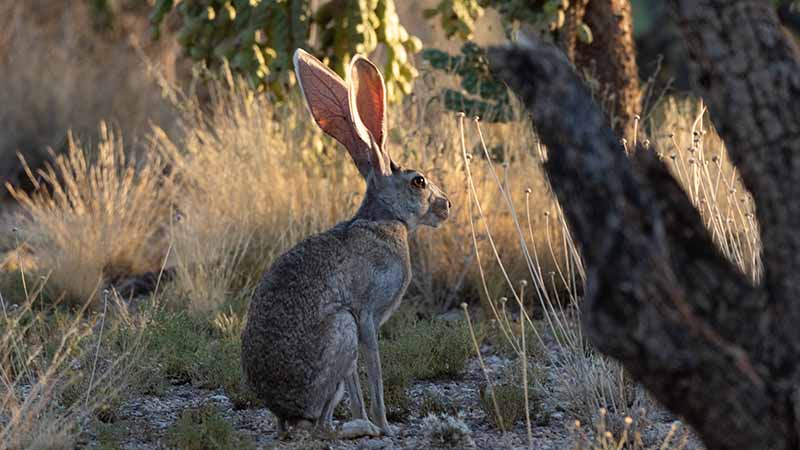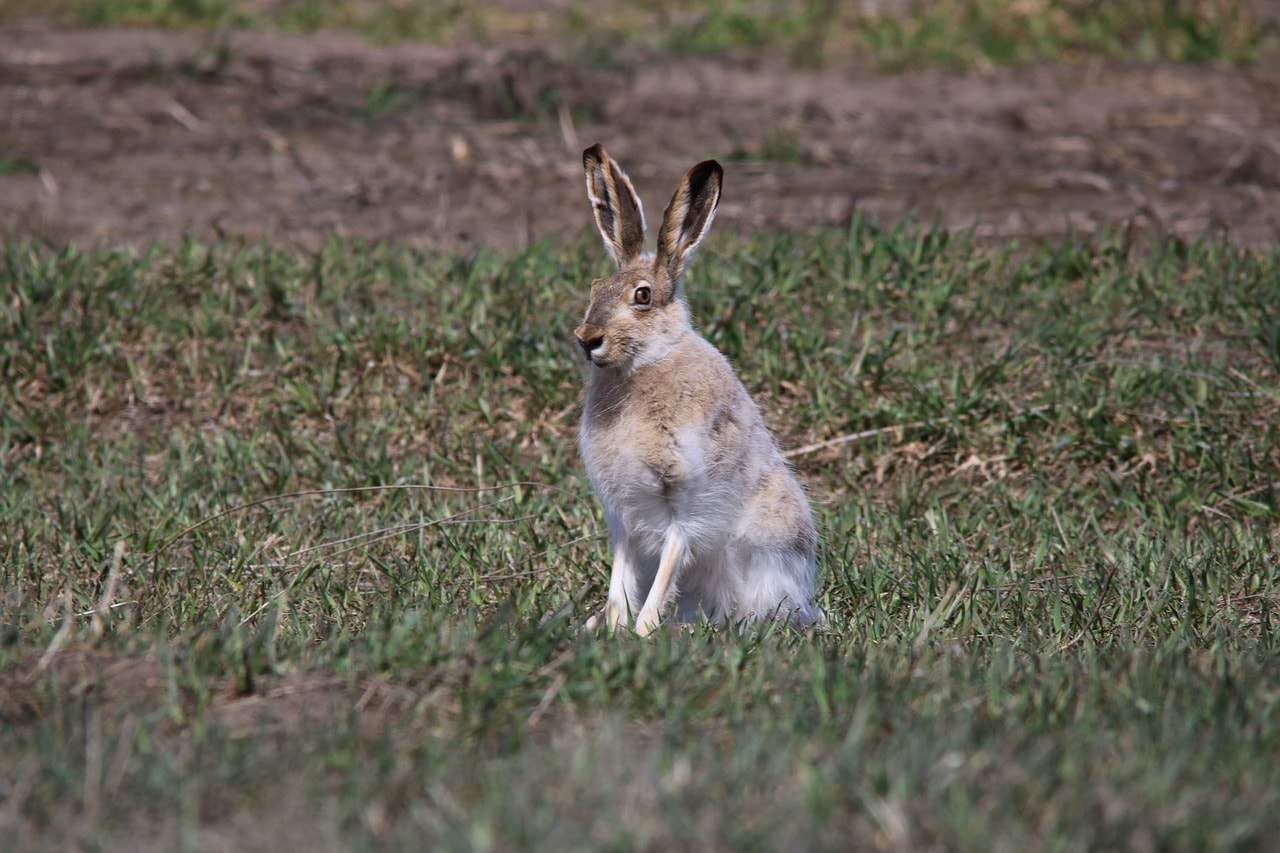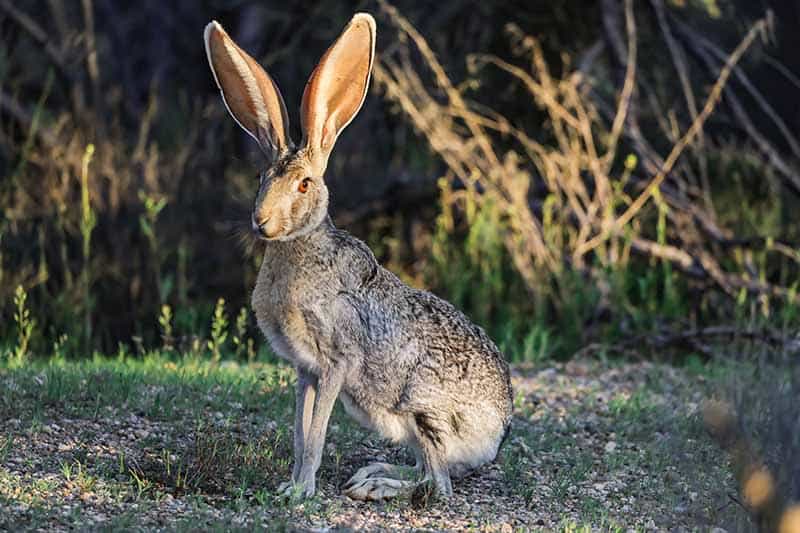Temperament
Food & Diet
Habitat
Exercise & Sleep
Population Threats
Mating Habits
Lifespan
Facts
[/jump-links]
Many people think a rabbit is a rabbit, whether domesticated or wild. This isn’t exactly true. The Antelope Jackrabbit is actually from the hare family. This also means that they are quite different from the domesticated rabbits we keep as pets. While some people feed Antelope Jackrabbits, they aren’t the type of animal that you can keep as a pet. We’ll go into everything you need to know about the Antelope Jackrabbit in the guide below, so join us.
| Height: | Standard |
| Weight: | 7 to 12 pounds |
| Lifespan: | 1 to 5 years |
| Similar Breeds: | Belgian Hare, Artic Hare, White Jackrabbit, Black Jackrabbit |
| Suitable for: | Admiring from a distance |
| Temperament: | Grey, white, brown, and a black mix |
The Antelope Jackrabbit is often seen as an invasive nuisance due to its ability to quickly destroy crops and gardens. However, some people feed and care for the hare, just not as a pet. The Antelope Jackrabbit is best admired from a distance, as nothing about them suggests they would make a good pet. You can admire its massive ears and impressive hopping ability but don’t try to pick up or pet the hare.
Antelope Jackrabbit Breed Characteristics
[yasr_multiset setid=7]

Origins of the Antelope Jackrabbit
The Antelope Jackrabbit has been around since the beginning of time, or at least before people started recording history. This hare breed is said to be descended from giant, prehistoric rabbits, which could account for their shape and size.
In fact, the Antelope Jackrabbit can be found in New Mexico and Arizona and has been there for thousands of years. The Jackrabbit got the name Antelope Jackrabbit because it looks so much like an antelope. It can also run up to 45 miles per hour and jump as high as 5 feet and as far as 22 feet. That might be why these animals aren’t the best pets; you’re unlikely to catch a pet that fast if it escapes!

Temperament & Intelligence of the Antelope Jackrabbit
Not much is known about the temperament of the Antelope Jackrabbit because, as previously stated, they don’t make good pets. However, they are solitary animals that are crepuscular and nocturnal. It is possible to see one in your backyard, but if you approach it, it will hop away quickly. Their massive ears help them locate predators, and their speed helps them escape when chased by larger animals.
Can These Rabbits Be Kept As Pets?
Antelope Jackrabbits do not make good pets. They haven’t been domesticated and are unlikely ever to be sold as pets. They are solitary creatures who won’t get along well in a social setting. If you decide to care for an Antelope Jackrabbit, it’s important to note that you can’t treat the hare as a traditional pet or even as you would another rabbit. You can provide hay, fruit, or veggies for them to eat, but we don’t recommend building hutches or trying to interact with an Antelope Jackrabbit.
Does This Rabbit Get Along With Other Animals?
The Antelope Jackrabbit will not get along with other pets in your yard and will quickly run if it detects one. Some species of domesticated rabbits do not get along with cats or dogs, and rabbits and hares typically regard larger animals as predators.

Things to Know About Antelope Jackrabbits
While it is possible to own an Antelope Jackrabbit, it’s not a good idea. However, you can take care of any you’ve seen on your property. In our next section, we’ll give you some information about the Antelope Jackrabbit’s food, habitat, exercise, and sleeping needs, as well as a few other things you might want to know.
Food & Diet Requirements
Antelope Jackrabbits are folivores, meaning they eat primarily leaves and foliage. They are also considered granivores, which eat grass and succulent plants. They thrive especially on fresh grass and other types of vegetation that they find. If there’s a drought, they survive on creosote, mesquite shrubs, and cacti.

Habitat
Antelope Jackrabbits don’t like the heat, and they are nocturnal, so during the day, they spend their days in what is known as shelter forms. They form these shelters by backing up into shrubs or cacti, and this helps them stay out of the extreme heat and sunlight until the sun goes down.
If you want to care for the Antelope Jackrabbits in your neighborhood, you can plant more shrubs and trees in your yard to provide shade. However, you might not see one unless you’re walking around your property at night.
Exercise & Sleeping Needs
Antelope Jackrabbits sleep during the day unless it’s super cloudy; then, you might see them out and about during the daylight hours. They are wild animals, so they get their exercise by running, jumping, and hunting.
Population Threats
According to the IUCN, the Antelope Jackrabbit is a common hare and is unlikely to become extinct. The main threat to the Antelope Jackrabbit, as with many other wild animals today, is the loss of their habitats. Housing developments, manufacturing plants, grazing lands, and other building projects have reduced the Antelope Jackrabbit’s habitat.
There are also threats from predators, such as coyotes, dogs, and other wild animals that see the Antelope Jackrabbit as prey. It is not a protected species, which means hunters aren’t limited by how many they can kill.
Mating Habits
Antelope Jackrabbits’ reproductive season is from late December to September usually. They’re polygynous, which means one male will mate will multiple females. The females are pregnant for 6 weeks and carry one to five babies at a time. The fathers don’t help with childrearing, and the mothers are known for hiding their young during the day and coming back to feed them at night.
Lifespan and Health Conditions
The lifespan of the Antelope Jackrabbit is from 1 to 5 years. Although several European hares have succumbed to various diseases, the Antelope Jackrabbit is relatively healthy. However, hares and rabbits are host species for tularemia, and hunters can contract the disease when cleaning Antelopes or rabbits.

Male vs. Female
There is little difference to note between the male and female Antelope Jackrabbits. However, females are more protective of their offspring since males run off after the kits are born.
3 Little-Known Facts About Antelope Jackrabbits
1. The Jackrabbit Is thought to be Named for its Large Ears
The Antelope Jackrabbit is rumored to have been named for its large ears. According to locals that have seen them, they have ears that look like donkey’s ears.
2. The Jackrabbit Is Often Seen as a Pest
Antelope Jackrabbits and all Jackrabbits are often seen as pests because they get into gardens and feed on crops. They have huge appetites and can eat over a pound of food in a day.
3. Jackrabbits Are Agile and Fast
Antelope jackrabbits can run up to 45 miles per hour, which helps them evade even the fastest predators.

Final Thoughts
Antelope Jackrabbits are hares that are not meant to be kept as pets. They are solitary nocturnal animals and prefer to be left alone. They don’t like the heat, so they hide during the day and run about at night. They run fast and are capable of jumping higher than most rabbits and hares.
If you’re considering caring for an Antelope Jackrabbit, it should only be until the rabbit is ready to be released back into the wild, as they don’t make good pets and won’t be happy being one. If you’re lucky enough to spot one during the day, you’ll appreciate its impressive ears and athletic prowess.
Related Reads:
- White-Tailed Jackrabbit Breed Info: Pictures, Traits, & Facts
- Black-Tailed Jackrabbit Breed Info: Pictures, Traits, & Facts
- San Juan Rabbit Breed Info: Pictures, Traits, & Facts
Featured Image Credit: Vincent Pro Photo, Shutterstock
